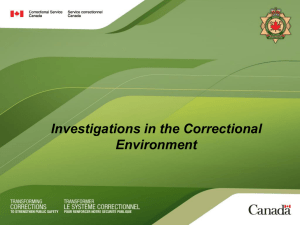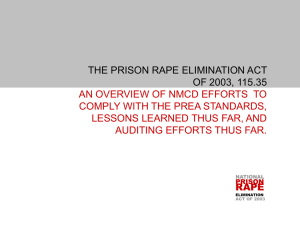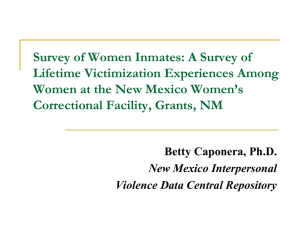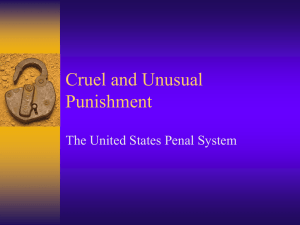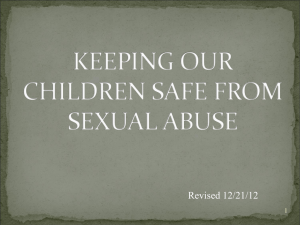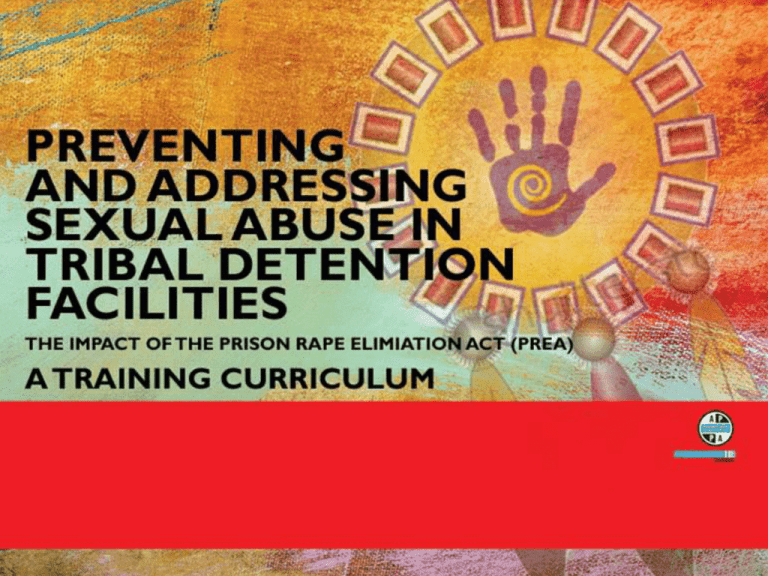
:
A Training Program by the American Probation & Parole Association
through funding from the Bureau of Justice Assistance,
U.S. Department of Justice
This project is supported by Award No. 2006-RP-BX-K001, awarded by the Bureau of Justice Assistance, Office of Justice Programs, U.S. Department of Justice. The Bureau of
Justice Assistance is a component of the Office of Justice Programs, which also includes the Bureau of Justice Statistics, the National Institute of Justice, the Office of Juvenile
Justice and Delinquency Prevention, the Office for Victims of Crime, and the Office of Sex Offender Sentencing, Monitoring, Apprehending, Registering, and Tracking. Points of
view in this document are those of the author and do not necessarily represent the official policies of the U.S. Department of Justice.
INTRODUCTIONS
PARTICIPANTS
FACILITATORS
LOGISTICS
CLASS EXCERCISE
WHAT DO YOU KNOW?
MODULE ONE
DEFINING THE ISSUE
&
UNDERSTANDING
THE PRISON RAPE
ELIMINATION ACT
MODULE ONE
OBJECTIVES
•Describe the Purpose & Implications of PREA
•Define Prohibited Behaviors
•List a Variety of Benefits of PREA
•Discuss Myths & Realities about Prison Rape
THE PRISON RAPE
ELIMINATION ACT
PREA
passed unanimously by Congress
in 2003.
PURPOSES OF PREA
•
•
•
•
ZERO TOLERANCE
NATIONAL STANDARDS
COLLECT DATA
ACCOUNTABILITY
WHO IS COVERED BY PREA?
Federal, State and Local
• Jails
• Prisons
• Lock-ups
• Temporary holding
• Juvenile facilities
• Community corrections facilities
WHY NOW?
• EVENTS OVER PAST 30 YEARS
– Civil rights acts
– National attention
– Key court cases
– Significant reports
NATIONAL STANDARDS
• Support national effort to eliminate
sexual abuse in custody
• Eliminate inconsistent efforts within
corrections
• Maintain credible data about incidents
IMPACT OF STANDARDS
• No criminal penalty in the actual law
• Reduction of federal funds if
noncompliant
• Increased civil liability
• Increased accountability to prevent and
address abuse
• Review policies and procedures
CLASS EXCERCISE
MY WORDS,YOUR WORDS –
ARE WE ON THE SAME PAGE?
CLASS DISCUSSION
In your own words, define:
•Sexual Abuse
•Sexual Harassment
•Staff Sexual Misconduct
DEFINITIONS
• Important to define prohibited behaviors
– Be specific
– Everyone understands
– Data collection purposes
• See Appendix for examples of what is
being used now
CLASS EXCERCISE
WHY DO I CARE?
WHAT ARE THE BENEFITS?
BENEFITS OF PREA
•
•
•
•
•
•
•
•
Safer work environment
High level of professionalism
Safety and security in facility
Integrity and respect
Reduces embarrassment
Reduces liability
Public safety
Public health
MYTHS
AND
REALITIES
MYTH 1
“We have no
reports of this
kind, so we don’t
have a problem.”
AND THE REALITY………………
MYTH 2
“Our jail is small,
so this kind of
activity does not
occur.”
AND THE REALITY………………
MYTH 3
“Inmates consent
to these
relationships
with staff.”
AND THE REALITY………………
MYTH 4
“Inmates are
inmates, and
they will act like
inmates not
matter what.”
AND THE REALITY………………
MYTH 5
“Employees are
clear about their
professional
boundaries.”
AND THE REALITY………………
MYTH 6
“It is the rookie
employee who is
most likely to get
involved
withmisconduct.”
AND THE REALITY………………
MYTH 7
“The real victims
of staff sexual
misconduct are
the employees
who are
manipulated by
the inmates.”
AND THE REALITY………………
MYTH 8
“Activities between
inmates, including
sexual behavior, is
part of what
happens normally in
jail. Inmates should
expect it.”
AND THE REALITY………………
MODULE TWO
DYNAMICS OF SEXUAL
ABUSE,VIOLENCE AND
MISCONDUCT IN
CUSTODIAL FACILITIES
MODULE TWO
OBJECTIVES
•Describe why people get involved
•Identify risk factors
•Identify the impact of victimization
•Identify RED FLAGS
•Demonstrate skills to protect oneself from
manipulation
•Discuss agency culture
•Discuss ethics and boundaries
INMATE
CHARACTERISTICS
WHAT MAKES THEM MORE
LIKELY TO PARTICIPATE IN
THIS BEHAVIOR?
CLASS DISCUSSION
What Does a Victim Look Like?
MENTAL HEALTH
• 64% in jails have mental health problems
• More mentally ill persons in jails and
prisons than hospitals
HISTORY OF PRIOR ABUSE
• Inmates with history or prior
sexual victimization are 6 times
more likely to be victimized or
display predatory behavior
TRIBAL STATISTICS
• 1.2 percent of those incarcerated in state
and federal facilities are American Indian
(but only 1 percent of total USA
population)
• 40 percent in tribal jails are violent
offenders
• Victimization rate in Indian Country
DOUBLE that of US citizens
• 1 in 3 women will be raped
THE CYCLE OF
VIOLENCE
Vulnerability
and
Predatory Behavior
INMATE SEXUAL ABUSE
Higher likelihood of victimization if:
• white or multi-racial, compared to black;
• college degree or higher, compared to high
school or less;
• gender preference other than
heterosexual;
• a history of prior sexual abuse.
STAFF WITH INMATES
More likely:
• among white inmates compared to black
inmates;
• among inmates age 25 or older,
• among inmates with college degrees;
• among inmates with a history or prior
sexual abuse;
• Most victims were male, and most
perpetrators were female.
HISTORY OF TRAUMA
(abuse or mental illness)
Less equipped to handle stress
Pessimistic view of world
More at risk for further victimization
Less able to distinguish unhealthy and
exploitative relationships
• PTSD
• Lie to protect their abusers
• More manipulative
•
•
•
•
CLASS EXCERCISE
RED FLAGS!
CLASS EXCERCISE
NOW WHAT DO I DO WITH
THIS INFORMATION?
CLASS EXCERCISE
CODE OF SILENCE – WHY INMATES
AND STAFF DON’T REPORT
MANIPULATIVE INMATES
• Fact of life
• Inmates find ways to gain control over
something – and you are generally the
target
• Fight or flight –a natural response to
incarceration
• A way to get something they want
PROTECTING OURSELVES
AGAINST MANIPULATION
Best Defense……….
• Know the rules & follow them
• Recognize manipulative attempts
• Be professional at ALL times
• Maintain clear professional boundaries
• Be respectful, but firm
CLASS EXCERCISE
Protecting Myself from Manipulation –
How does my Response Control the Outcome?
AGENCY CULTURE
• The total of the attitudes,
behaviors, beliefs, traditions and
practices of present and past
employees.
• Determines what is acceptable and
unacceptable behavior in the
workplace.
CULTURE IMPACTS SEXUAL
ABUSE IN FACILITY
• Lack of respect = inappropriateness
• Lack of trust = silence and secrets
• Lack of respect for inmate rights = failure to
protect human rights
• Lack of training = unprofessionalism
• Lack of dialogue about the issue =
misunderstanding & ignorance
ETHICS
• Principles of right or good conduct
• Moral principles and values
• Rules or standards governing
professional conduct
WHY DO WE CARE ABOUT
ETHICS?
•
•
•
•
We want to do the right thing
Ethical behavior is good for business
Unethical behavior has consequences
Lack of ethics causes chaos and danger
ETHICAL DECISION
MAKING
1.
2.
3.
4.
5.
6.
7.
Define the issue
Gather information
Pros and cons?
Agency mission?
Rules and regulations?
Consequences?
Live with your decision?
QUESTIONS TO ASK
YOURSELF
? Would I get permission?
? Is it legal?
? Would co-workers approve?
? Would superiors approve?
? Would family approve?
? Does it reflect my moral beliefs?
CLASS EXCERCISE
Is it Ethical?
Case Studies in Decision Making
MODULE THREE
INVESTIGATIONS
AND
LEGAL CONCERNS
MODULE THREE
OBJECTIVES
•Describe unique nature of sexual abuse
investigations
•List First Responder duties
•Identify Rights and Responsibilities while
under investigation
•Discuss legal concerns and consequences
INVESTIGATIONS
CRITICAL TO PREVENTION
•Competent investigations build trust in
the process
•Competent investigators find the truth
•Fair and consistent sanctions build
professionalism
•Competent investigations are a
deterrent to sexual abuse
UNIQUE NATURE OF SEXUAL
ABUSE INVESTIGATIONS
•
•
•
•
•
•
•
•
Mental and physical state of victim
Sensitive and personal issue
Safety for victims is at risk
Victims responds differently
Embarrassment
Complicated physical evidence
Special training needed
Medical & mental health needs
FIRST
RESPONDERS
What we need to do……….
and NOT do!
#1 - RENDER AID
•
•
•
•
•
Physical condition
Mental state
Victims are in shock
Use a gentle manner with victim
Be aware of how differently victims may
respond and act
#2 - PRESERVE SAFETY
AND SECURITY
• Relocate the inmate?
• Relocate employee, if accused?
• Check emergency response procedures
# 3 - PRESERVE EVIDENCE
• Could evidence be present?
• Let no one unauthorized near the scene or
evidence
• Victim - No washing of person or clothes,
depending on time frame
• Don’t interview without permission from
investigator
• Document everything – statements,
comments, potential witnesses
# 4 - MAKE APPROPRIATE
NOTIFICATIONS
•
•
•
•
•
Follow procedures
Notify supervisor, etc.
Know the policy for who to notify
Assure that investigators are notified
Maintain confidentiality – don’t talk to
anyone except those authorized
# 5 - ASSIST
INVESTIGATORS
• Provide all information you have when
they arrive
• Don’t interfere or interrupt the
investigation
• Take notes
• Offer assistance when asked
# 6 - DOCUMENT
EVERYTHING
•
•
•
•
•
What you saw
What you heard
What you did as first responder
Names of those present
Names of potential witnesses, suspects
# 7 - BE OBSERVANT
• Duties don’t end when investigator
arrives
• Be observant for activity and comments
as time goes by
• Observe to protect victim
• Observe to protect against retaliatory
acts
# 8 - BE PREPARED
• Know policy and procedure
• Know your responsibilities
• Be familiar with dynamics of
victimization
• Know what is going on around you at all
times
• Do you own research about First
Responding
CLASS EXCERCISE
What do I do now?
Real events for First Responders
I AM UNDER
INVESTIGATION !
NOW WHAT?
CLASS EXCERCISE
The Path of an Investigation –
Do I Know What Happens?
MY RIGHTS AND
PROTECTIONS
• To be notified
• During questioning –
– Miranda – right against self-incrimination (criminal
invest.)
– Garrity – compelled statements (administrative
invest.)
• Time frames
• Due process – right to hearing
• Outcome – notification & appeal rights
MY RESPONSIBILITIES
•
•
•
•
Maintain confidentiality
Stop talking about it
Cooperate
Truthfulness
INMATE RIGHTS &
PROTECTIONS
• Indian Civil Rights Act
– Civil suits in Indian Country have been limited
– Can be handled in Federal torts court
– Protects them from abuse in custody – “cruel
and unusual punishment”
– Right to due process – a hearing
LEGAL CONSEQUENCES
FOR STAFF SEXUAL
MISCONDUCT
• PREA Standards increase accountability and
potential liability
• Criminal prosecution for employees and
inmates
– Tribal Codes and Laws
– Major Crimes Act – some tribes
– General Crimes Act – non-Indian perp.
– PL280 – some state laws
CLASS DISCUSSION
REAL CASES, REAL PEOPLE
LESSONS LEARNED
What lessons can we learn
from real cases and events?
THE BIG 3
Agencies fail most frequently through
negligent:
1. TRAINING
2. INVESTIGATIONS
3. POLICY & PROCEDURE
PREVENTION LESSONS
TRAINING
• Train everyone
– Employees – extensive training
– Inmates – yes, inmates!
– Contractors
– Vendors
– Volunteers
– Anyone who has contact with inmates
PREVENTION LESSONS
INVESTIGATIONS
• Special training for investigators
• Consistent, fair
• Confidential
• Timely
• Remember – this is a different type of
investigation
PREVENTION LESSONS
POLICY & PROCEDURE
• Specific to the issue
• Define prohibited behaviors
• Train all on P&P
• Clear expectations
• Clear disciplinary process
• Update regularly
MODULE FOUR
PREA STANDARDS
MODULE FOUR
OBJECTIVES
• List 2-3 PREA Standards
• Describe Impact on Policy and Procedure
• Discuss requirements for National Data
Collection participation
WHAT ARE THE
STANDARDS?
41 STANDARDS intended to:
• Provide guidelines
• Demonstrate best practices
• Achieve consistent level of competency
and professionalism
HOW WERE STANDARDS
DEVELOPED?
• By a National Commission
• Set of hearings with corrections and law
enforcement, tribal representatives,
victims and advocates
• Draft standards to the U.S. Attorney
General
• Currently in final process.
PREA DATA COLLECTION
•
•
•
•
Annually to BJS
Information on all reported incidents
Based on definitions of behaviors
Creates national data base
CLASS DISCUSSION
SELECTED STANDARDS FOR
DISCUSSION
115.33 (TR3)
INMATE EDUCATION
• During intake process
• More comprehensive after 30 days
• Inmates advised of:
– Right to be free from abuse
– Right to be free from retaliation
– How to report
– Agency policy
115.41 (SC1)
SCREENING INMATES
FOR RISK
• Inmates screened at intake and
subsequent reviews to determine risk
• Screened for risk factors listed in
standard
• Agency uses standard forms for screening
115.14
LIMITS TO CROSS-GENDER
VIEWING AND SEARCHES
• Cross-gender strip search only in
emergency or by medical
• Only medical to search to determine
genital status
• Train all staff to perform proper crossgender and transgender pat-downs.
MODULE FIVE
PUTTING INTO
PRACTICE WHAT WE
KNOW
MODULE FIVE
OBJECTIVES
•
•
•
•
Demonstrate Knowledge of Subject
Create useful Tools
Discuss Information Learned
Develop a Plan of Action
CLASS EXCERCISE
Let’s Get to Work!
ACTION PLAN
QUICK FIRE
When I get back to my facility,
one thing that I want to do to
or change is_____________
POST-TEST
EVALUATIONS
RESOURCES

